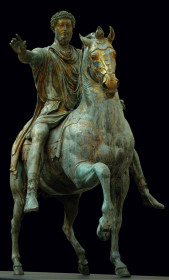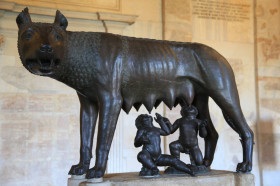Capitoline museums are settled on the Capitoline hill, one of the Seven Hills of Rome. After the groups of people lived on those hills started to communicate and played a series of religious games, the bonding between those groups became stronger. When the valleys between the hills were turned into markets, the whole area slowly grew as a united place with having different groups living and reciprocating with each other. After the hills conjoined more like a city, they were protected by the famous 11 km long Servian wall. These high walls are still there around the ancient city of Rome.
On this historical hill, in 1471, world’s first public museum was founded by Pope Sixtus IV. Pope donated some valuable ancient bronze sculptures to the people of Rome and decided to exhibit them on the Capitoline hill. Thus the foundation of the Capitoline museums was commenced at that time. Later in 1536, Michelangelo expended the area with plan of another building called Palazzo dei Conservatori.
The collection and ancient artifacts were increased years by years in the museum by purchases and donations. Currently, the three buildings of the museum hold thousands of artifacts in its oeuvre.
The Buildings
As mentioned before, there are three buildings in the premise. It is Michelangelo’s design back in mid-16th century.
Though, Michelangelo didn’t build the whole premise. Palazzo del Senatore (Senatorial Palace) and palazzo dei Conservatori (Palace of the conservators) were already there. First was built in around 12th century while the other one was just renovated by Michelangelo in 1536 with one of the first use of Giant Order Columns. This style contains pilasters span two or more stories in the building. It helped the buildings to acquire a unique grandeur.
The other building, Palazzo Nouvo’s (New Palace) construction started in 1603 and was finished in 1654. But the revelation to the general public was not until 1734. It was made symmetrical from outside to the palazzo dei Conservatori.
With identical exterior, Palazzo dei Conservatori and Palazzo Nouvo face each other. Thus, it is giving the whole premise a fine sense of balance.
Galleria Lapidaria – The Underground Gallery
This gallery was built in late 1930s to link the two buildings while workers found a road which was used for Capitoline Hill to the Campus Martius. Currently, the gallery exhibits ancient artifacts on both sides.
Statue of Marcus Aurelius and the myth
 In the middle of the three buildings there is an equestrian statue of Marcus Aurelius. Though, it is the replica of the original. The original bronze statue is located inside the museum with care. The reason to put Marcus Aurelius is considered as the demonstration of the power and divine grandeur. The notable thing of the statue is that rider is sat without the stirrups in legs. At that time, the stirrups were not introduced to west. The importance of the statue can be sensed when we found its depiction on the coin of 0.50 pound Euro. There is also a replica of this statue in the campus of Brown University, US.
In the middle of the three buildings there is an equestrian statue of Marcus Aurelius. Though, it is the replica of the original. The original bronze statue is located inside the museum with care. The reason to put Marcus Aurelius is considered as the demonstration of the power and divine grandeur. The notable thing of the statue is that rider is sat without the stirrups in legs. At that time, the stirrups were not introduced to west. The importance of the statue can be sensed when we found its depiction on the coin of 0.50 pound Euro. There is also a replica of this statue in the campus of Brown University, US.
A little story rambles in the local community. The fable says that the statue was clad in gold formerly. And it will turn into gold again on the ‘judgment day’. People always find amusement in making out stories!
The important Artifacts:
Being world’s oldest museum, Capitoline Museum, has many important artifacts from history. Though, like in Louvre Museum the main attraction is the Mona Lisa paintings, here we can consider the She-wolf or Capitoline Wolf. It is a bronze sculpture of a she-world suckling two infants. The theme is taken from the legend of Founding the Rome.
In the story, twins Romulus and Remus were flung into Tiber River by their uncle Amulius, they were rescued by a she-wolf and were protected until a herdsman, Faustulus found and raised them.
 The Capitoline wolf has been in palazzo dei Conservatori since 1471.
The Capitoline wolf has been in palazzo dei Conservatori since 1471.
Other notable works preserved in the library are statues of Dying Gaul, Cupid and Psyche, Heracles fighting, Leda and the Swan and Bernini’s Medusa. Though there are numerous other artifacts lined up in the royal rooms and corridors of the museum.
Preserving the important artifacts and exploring the history is the motto of every museum in the world. Even a single museum’s artworks are considered priceless, thus we can’t even imagine the value of enormous treasure of history of arts, science, literature and every other subjects is being well-preserved in the museums around the world. The museum of Capitoline started it all.


